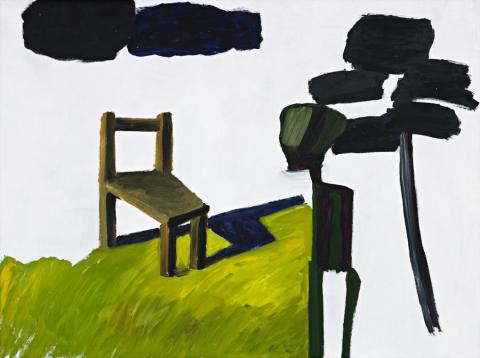GREEN MAN, TREE AND CHAIR, 1974
KEN WHISSON
oil and enamel on composition board
81.0 x 108.0 cm
dated and inscribed verso: 31 MAY 1974 / ... "GREEN MAN / TREE AND CHAIR" ...
Ray Hughes Gallery, Brisbane (inscribed by artist verso)
Esa Jaske, Sydney
Private collection, Brisbane
Ken Whisson: As If, Heide Museum of Modern Art, Heide, 17 March - 15 July 2012, and Museum of Contemporary Art, Sydney, 28 September - 25 November 2012
Ken Whisson Paintings 1947-1999, Niagara Publishing, Melbourne, 2001, pp. 42, 120 (illus. p. 42)
Barkley G., and Harding, L., Ken Whisson: As If, Heide Museum of Modern Art, Melbourne and Museum of Contemporary Art, Sydney, 2012, cat. 75, pp. 6-7, [81], 153 (illus.)
'My paintings have a much better memory than I do for the things I've seen ... a much clearer memory, they seem to remember a lot of things that I don't remember.'
Fundamental to the highly enigmatic, gestural form of abstraction for which Ken Whisson has become renowned is the premise that art should be produced with intuitive spontaneity. As illuminated in his lecture on 'Technique and Intuition' at the Ballarat Art School in 1994, Whisson believes artistic creation reaches its zenith in the moment where the artist's conscious eyes and mind are totally surprised by what the brush has intuitively produced: '... By not looking at your own work you don't lose the thread of development, the ideas and developments come back from that dark pile of hidden paintings in a way that they will not come back if you look at them and wonder about them, have doubts, or worse, let them seduce you into thinking that what you have already done is your style and way of painting.'1
Interestingly, this honest and unpretentious approach to painting has resulted in a truly sophisticated, complex visual language that exerts increasingly compelling appeal on the viewer. Oscillating between figuration and abstraction, images from the artist's memory typically emerge upon his canvas in the manner of a discontinuous slideshow where planes and objects are simultaneously established and disrupted. Thus, forms that initially seemed disordered and unrelated, floating in spatial ambiguity, gradually become recognisable to create a visually dynamic arrangement that encourages '... the viewer to see with the eye of the mind rather than expecting a perfect match between an object and its representation.'2
Like the celebrated Disembarkation for Cythera (Idiot Wind), 1976 and Jean's Farm, 1975 (both in the National Gallery of Australia, Canberra), the present Green Man, Tree and Chair, 1974 belongs to the artist's arguably most original and highly coveted period in which he immortalises aspects of his daily experience of living in St Kilda, Melbourne during the 1970s. Characterised by brighter, fresher colours, more confidently sculpted forms and a whimsical sense of space that imbues a certain playfulness to his work, indeed it was this chapter of his oeuvre which importantly established Whisson's reputation as 'an artist's artist'.
1. Whisson, K., 'Talk 1994' reproduced in Ken Whisson: Paintings 1947-1999, Niagara Publishing, Melbourne, 2001, p. 43
2. McDonald, J., 'Introduction', cited ibid., p. 9
VERONICA ANGELATOS
